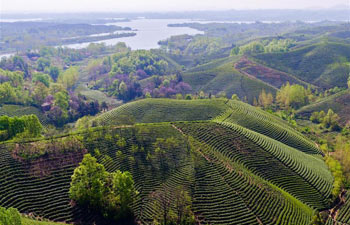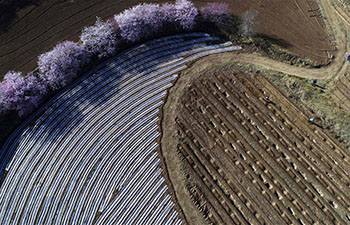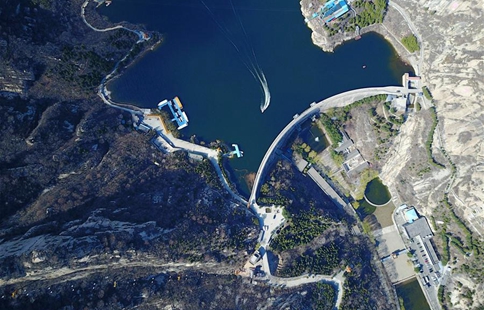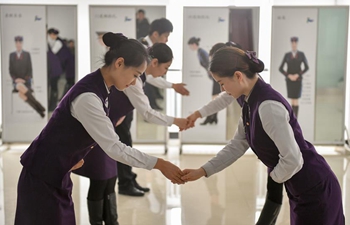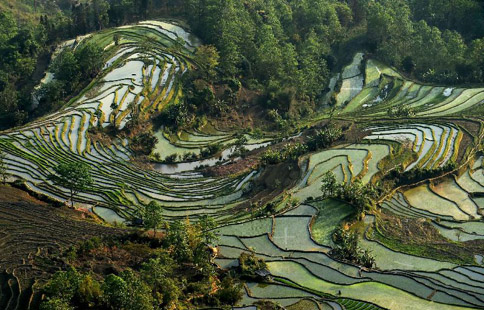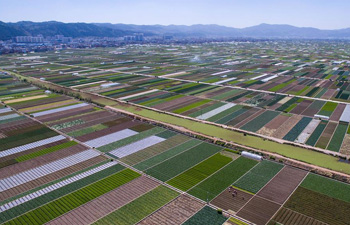
Container freighter Netherlands of China Ocean Shipping (Group) Company (COSCO) anchors at a wharf in east China's Shanghai Municipality, April 15, 2017. Container freighter Netherlands will stop by Singapore, the Suez Canal, Rotterdam, Hamburg, Antwerp and the Pireaus Port in Greece after it leaves Shanghai. (Xinhua/Chen Fei)
by Xinhua writers Yan Liang, Zheng Kaijun
SHANGHAI, April 16 (Xinhua) -- One of today's most technically-advanced ships in the world set sail from here on Sunday to retrace the oldest maritime route that linked China with the rest of the world.
Merchant Vessel (M.V.) COSCO Netherlands is leaving Yangshan Deep Water Port at 7 p.m. local time (1100 GMT), in Shanghai, the world's largest cargo port, and will dock in the Port of Ningbo in east China, the Port of Singapore, the Suez Canal, the Pireaus Port in Greece, and ports in Rotterdam of Netherlands, Hamburg of Germany, and Antwerp of Belgium, in its about 40-day journey.
Products with internationally well-known brand, like Hewlett-Packard (HP) computers, Sony LCD monitors, Hisense TV, Haier refrigerators, automobile spare parts and bicycles, assembled or made in China, are on board for export to northwestern European and other countries.
An over 150,000 ton oceangoing container vessel, the giant is 366-meter long, 51.2-meter wide and 67-meter high, and can carry up to 13,386 TEU (20 foot equivalent unit). It was manufactured by China's Nantong COSCO KHI Ship Engineering Co., Ltd. in 2013.
China COSCO Shipping Corporation Limited, owner of M.V. COSCO Netherlands, offers service on more than 100 routes globally, including those from the Far East to northwestern Europe, the Mediterranean, the Middle East and Africa, as well as regional feeders within Europe and Southeast Asia nations. Part of the route that M.V.COSCO Netherlands travels overlaps with the ancient Maritime Silk Road and its history can be traced back to ancient time.
Yao Wei, a 30-year-old engine room engineman from Jiangsu Province, first time on board M.V. COSCO Netherlands, told Xinhua, "I am very looking forward to this new journey, from history to reality, from China to Europe. It must be very impressive."
The ancient Maritime Silk Road was a crucial conduit for trade and cultural exchanges between China's southeastern coastal regions and countries in Southeast Asia, Africa and Europe.
It was first formed in the Qin and Han Dynasties (221 B.C.-220 A.D.), developed from the Three Kingdoms Period to Sui Dynasty (220-618 A.D.), flourished in the Tang and Song Dynasties (618-1279 A.D.), and fell into decline in the Ming and Qing Dynasties (1368-1911 A.D.).
Through the sea route, silk, tea and china were exported, while spices and rare treasures like precious stones were brought to China.
During the Yuan Dynasty (1279-1368 A.D.), renowned Italian traveler and explorer Marco Polo headed for China along the Silk Road. After living in China for 17 years, he left from Quanzhou, a coastal city in southeast China's Fujian Province, or one of the starting points of the ancient Maritime Silk Road.
Marco Polo's remarks and memories of China were recorded in the book -- the Travels of Marco Polo, which described China's politics, economy, culture and prosperity in detail at that time.
As ancient trade through sailing driven by monsoons and ocean currents gave way to the transoceanic trade via container freighters between China and Europe, the Maritime Silk Road has also witnessed the growth of cultural exchanges and mutual learning among civilizations.
Now, the Silk Road Economic Belt and the 21st Century Maritime Silk Road, or together the Belt and Road Initiative, proposed by Chinese President Xi Jinping in 2013, aim to build an even stronger trade and infrastructure network connecting Asia with Europe and Africa along the ancient trade routes and promote common development among all countries involved.
In May this year, China will host the Belt and Road Forum for International Cooperation in Beijing, during which participants will have an opportunity to explore cooperation opportunities, build cooperation platforms and share the outcomes of cooperation.









